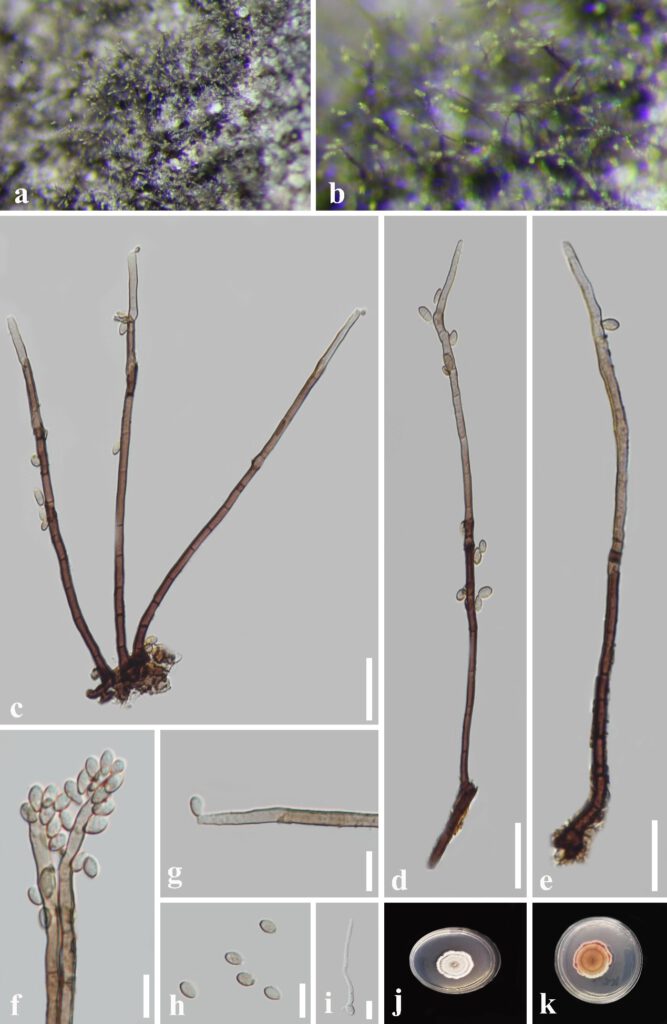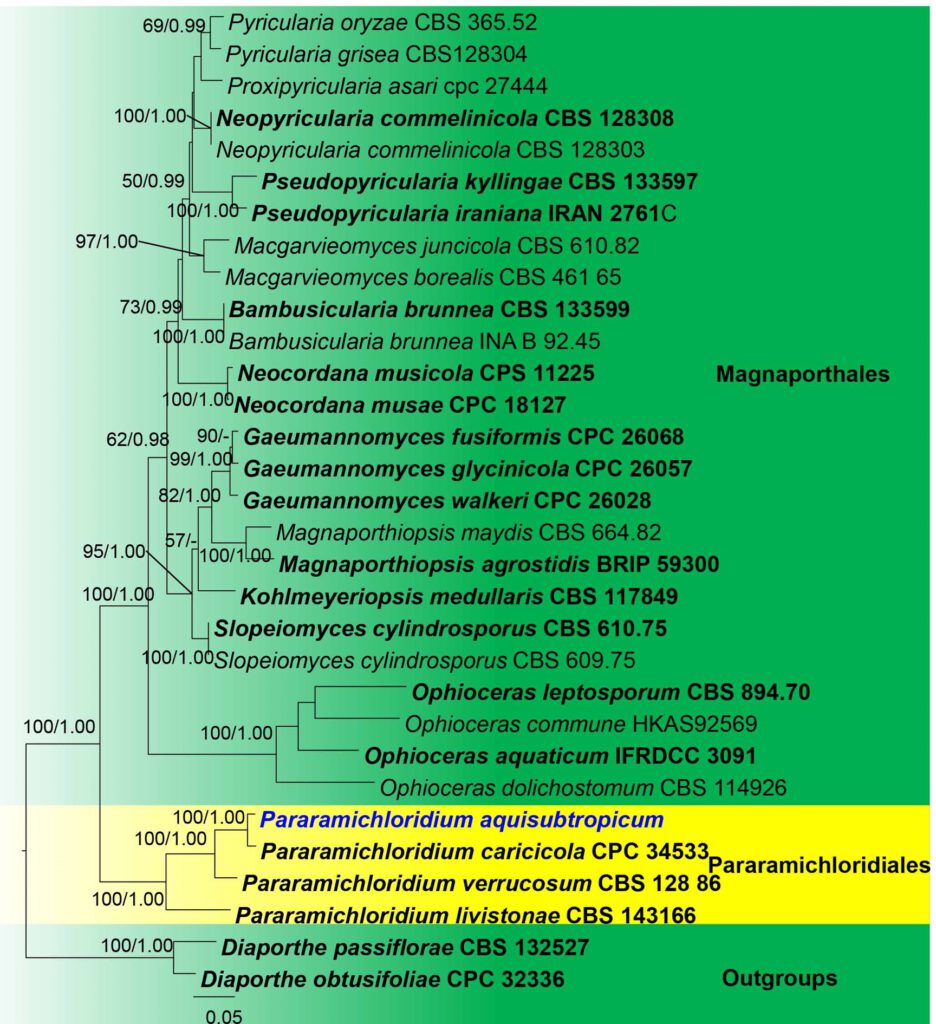Pararamichloridium aquisubtropicum J.Y. Zhang, Y.Z. Lu & K.D. Hyde sp. nov. (Figure 3)
MycoBank number: MB; Index Fungorum number: IF; Facesoffungi number: FoF 10677
Etymology: Referring to the quatic habitat and collecting site in subtropical country, China.
Holotype: GZAAS 21-0382
Saprobic on submerged decaying wood. Asexual morph Colonies on natural substrate superficial, brown, smooth, solitary. Mycelium partly immersed, consisting of branched, smooth, brown hyphae. Conidiophores 119–202 × 2.6–4.7 μm (x¯ = 161.4 × 3.6 μm, n = 24), macronematous, mononematous, sucylindrical, straight, unbranched, brown, smooth, 6–9-septate. Conidiogenous cells 27.3–37 × 2.6–3.8 μm (x¯ = 27.6 × 3.3 μm, n = 15), holoblastic, polyblastic, integrated, terminal, subhyaline to pale brown, subcylindrical. Conidia 4–8 × 3–4.7 μm (x¯ = 5.2 × 3.7 μm, n = 25), acrogenous, solitary, aseptate, pale brown, globose to subglobose. Sexual morph: Not observed.
Culture Characters: Colonies on PDA reaching 33 mm in 44 days at 25 °C, flat, curler, near-round or round, gray, smooth, middle erumpent; In reverse, yellow at the center, lightly brown or gray at the margin.
Material examined: China, Guizhou Province, Xishui County, on decaying wood submerged in a freshwater stream, 16 September 2020, Jian Ma, XY2(GZAAS 21-0382, holotype); ex-type living culture, GZCC 21-0668. GenBank ITS:xxxx; LSU:xxxx.
Notes: The phylogenetic analysis (Fig. 4) revealed that Pararamichloridium aquisubtropicum forms distinct lineage belonging to the genus Pararamichloridium, where it is sister to P. caricicola with high support (100% BS, 1.00 PP). P. caricicola is the closest species based on BLAST result of LSU and ITS region with 99.55% and 96.11% similarity, respectively. P. caricicola is found from culture, while our new collection was saprobic on submerged decaying wood. Pararamichloridium aquisubtropicum shares the same morphology with P. caricicola in having brown, septate, smooth conidiofores, integrated, terminal, subcylindrical conidiogenous cells and ellipsoid, pale brown aseptate, conidia. However, P. aquisubtropicum differs from P. caricicola by it darker and longer (119–202 ×2.5–4.7 μm vs 35–100 ×2.5–3 μm) conidiophores. Thus, P. aquisubtropicum is introduced here as a distinct novel species based on its distinct morphological features and phylogenetic placement.

Fig. 3 Pararamichloridium aquisubtropicum (GZAAS 21-0382, Holotype) a–b Colony on decaying wood c–e Conidiophores with attached conidia d–g Conidiogenous cells and conidia h Conidia i Germinating condium j–k Colony on PDA from above and below. Scale bars: c-e = 20 μm, f-i = 10 μm

Fig. 4 Phylogram generated from maximum likelihood analysis based on combined LSU and ITS sequence data. Twenty-two taxa were included in the combined analyses, which comprised 1524 characters (LSU: 885, ITS: 639) after alignment. The best scoring RA × ML tree with a final likelihood value of -9344.210259 is presented. The matrix had 613 distinct alignment patterns, with 12.81% of undetermined characters or gaps. Estimated base frequencies were as follows: A = 0.245485, C = 0.254685, G = 0.293576, T = 0.206254; substitution rates: AC = 1.812344, AG = 1.790002, AT = 2.248990, CG = 1.318744, CT = 6.462454, GT = 1.000000; gamma distribution shape parameter α = 0.228928. Bootstrap support values for ML equal to or greater than 50% and BYPP equal to or greater than 0.95 are given above the nodes. The tree is rooted with Diaporthe passiforae CBS 132527 and D. obtusifoliae CPC 32226. The newly generated sequence is indicated in blue. The ex-type strains are indicated in bold.
